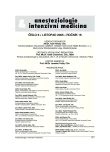A comparison of the effectiveness of continuous positive airway pressure and high-frequency jet ventilation applied by naso-oral mask in patients treated for pulmonary oedema
Porovnanie účinnosti kontinuálneho pretlaku v dýchacích cestách CPAP a vysokofrekvenčnej dýzovej ventilácie nazo-orálnou maskou (VFDV-M) v liečbe edému pľúc
Cieľ štúdie:
V retrospektívnej štúdii autori porovnávali efektivitu CPAP (continuous positive airway pressure) a vysokofrekvenčnej dýzovej ventilácie aplikovanej maskou (VFDV-M) v liečbe kardiogénneho pľúcneho edému.
Typ štúdie:
Retrospektívna štúdia.
Názov a sídlo pracoviska:
Oddelenie anestéziológie a intenzívnej medicíny.
Materiál a metodika:
Do štúdie bolo zaradených 196 pacientov prijatých pre niektorú formu kardiogénneho edému pľúc (PE). Pacienti boli rozdelení do 3 skupín podľa závažnosti PE. Pri porovnateľnej farmakoterapii a porovnateľnom strednom tlaku v dýchacích cestách a FiO2, autori porovnávali účinnosť (CPAP u 64 pacientov vs. VFDV-M u 132 pacientov) na rýchlosť zníženia ventilačnej frekvencie, oxygenáciu, acidobázickú rovnováhu, ako aj dobu nevyhnutnej ventilačnej podpory a dobu hospitalizácie na OAIM. Výsledky hodnotili nepárovým Studentovým t-testom.
Výsledky:
U ľahších foriem PE (1. štádium PE), sa štatisticky významný rozdiel v hodnotených parametroch pri aplikácii CPAP alebo VFDV-M nenašiel. U ťažkých foriem (2. a 3. štádium PE) sa dokázali štatisticky významné rozdiely v rýchlosti poklesu spontánnej ventilačnej frekvencie z hodnôt 25–33 d/min na 18–22 d/min (p < 0,01) za prvé 3 hodiny ventilačnej podpory v prospech pacientov ventilovaných VFDV-M. Podobne štatisticky významný rozdiel našli v rýchlosti úpravy PaO2, pH a indexu PaO2/FiO2 (p < 0,01) hlavne počas prvých 2 hodín terapie v prospech skupiny VFDV-M. Pri porovnávaní zmien PaCO2 sa štatisticky významný rozdiel nedokázal. Pri porovnaní priemernej dĺžky nevyhnutnej ventilačnej podpory 10,9 vs. 6,8 hodín (CPAP vs. VFDV-M) a priemernej doby hospitalizácie 2,7 vs. 2,0 dňa (CPAP vs. VFDV-M) zistili štatisticky významné rozdiely (p < 0,01, resp. p < 0,05). Z pacientov zaradených do štúdie len 8,2 % bolo nevyhnutné intubovať a ventilovať konvenčnými spôsobmi ventilácie.
Záver:
Ventilačná podpora VFDV-M je v porovnaní s CPAP efektívnejšia už v prvých 2–5 hodinách terapie a pri aplikácii VFDV-M sa štatisticky významne skracuje nevyhnutný čas ventilačnej podpory, ako aj pobyt na OAIM, pričom nutnosť intubácie sa znižuje na 8,2 % pacientov.
Kľúčové slová:
neinvazívna ventilácia – CPAP – vysokofrekvenčná dýzová ventilácia maskou – edém pľúc
Authors:
P. Čandík; E. Drbjáková; I. Lakatoš; P. Toya; J. Šalantay; P. Čičatko
Authors‘ workplace:
Oddelenie anestéziológie a intenzívnej medicíny NsP Vranov nad Topľou, Slovenská republika
Published in:
Anest. intenziv. Med., 16, 2005, č. 6, s. 284-290
Category:
Intensive Care Medicine - Original Paper
Overview
Objective:
Comparison of continuous positive airway pressure (CPAP) and high-frequency jet ventilation applied by naso-oral mask (HFJV-M) in patients treated for cardiogenic pulmonary oedema (PO).
Design:
Retrospective study.
Setting:
Department of Anaesthesia and Intensive Care Medicine.
Material and Methods:
A group of 196 patients admitted for PO were stratified to 3 subgroups in accordance with the seriousness of the PO. The decrease in spontaneous respiratory rate, oxygenation, length of ventilatory support and length of stay in the ICU were used as indicators of treatment effectiveness (CPAP in 64 patients and HFJV-M in 132 patients) while pharmacotherapy, mean airway pressure and FiO2 values remained very similar. The results were analysed using Student’s T-test.
Results:
There were no statistically significant differences in the studied parameters between CPAP and HFJV-M in the subgroup with mild PO (subgroup 1). In the subgroups with more severe PO (subgroups 2 and 3) there were statistically significant differences in the decrease of spontaneous respiratory rate from 25-33 bpm to 18-22 bpm (P < 0.01) in the first 3 hours of ventilatory support in favour of patients ventilated by HFJV-M. Similarly, there was a statistically significant difference in the rate of improvement of PaO2, pH and PaO2/FiO2 index (P < 0.01) mainly during the first 2 hours of therapy again in favour of HFJV-M. There was no significant difference in the change of PaCO2 between the two treatments. The length of required ventilatory support was 10.9 vs. 6.8 hours (CPAP vs. HFJV-M). The average length of stay in the ICU was 2.7 vs. 2.0 days, which is statistically significant (P < 0.01 vs. P < 0.05). Only 8.2% of patients participating in the study ultimately required tracheal intubation and conventional mechanical ventilation.
Conclusion:
HFJV-M is more effective than CPAP during the first 2-5 hours of therapy. The application of HFJV-M significantly shortens the length of required ventilatory support and the length of stay in the ICU. The overall incidence of tracheal intubation was low at 8.2 %.
Key words:
Non-invasive ventilation – CPAP – HFJV-M – pulmonary oedema
Labels
Anaesthesiology, Resuscitation and Inten Intensive Care MedicineArticle was published in
Anaesthesiology and Intensive Care Medicine

2005 Issue 6
Most read in this issue
- The role of linezolide in the treatment of resistant gram-positive infections
- A comparison of the effectiveness of continuous positive airway pressure and high-frequency jet ventilation applied by naso-oral mask in patients treated for pulmonary oedema
- Predictive factors of failure of non-invasive positive pressure ventilation in patients with acute respiratory failure due to exacerbation of chronic obstructive airway disease
- Administration of recombinant activated factor VII (rFVIIa) in non-haemophiliac patients in the Czech Republic – analysis of selected data from the UniSeven register
